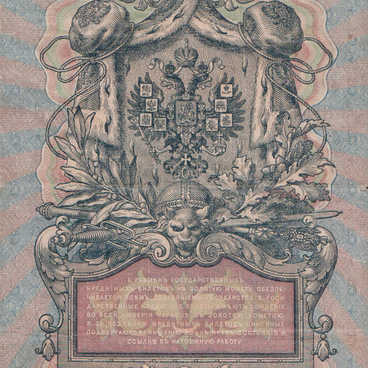The design of a 50-ruble banknote of the 1899 model remained unchanged until the end of the Russian Empire, although it was issued not only during the monarchy, but also under the Provisional Government and the Bolsheviks.
The design of this note included far fewer ornamentation elements than the notes issued later. Nevertheless, the baroque elements on this note predated the decoration of the banknotes designed in 1909–1912.
This type of banknote remained legal tender until 1922, when it was exchanged for new money. The banknote bore an image of Emperor Nicholas I.
Nicholas I was a rather controversial ruler for many educated Russians even in the early 20th century. The most liberal circles saw him as the strangler of freedom in the country; he evoked associations with the “cast-iron” censorship statute and with the Third Department, which dealt with political investigations in the Russian Empire. The Emperor’s complicated attitude towards the peasant issue also did not add to his credibility in Russia’s most democratic circles. The reign of Nicholas I ended with severe defeat in the Crimean War, which was fought simultaneously against the coalition of states (Great Britain, France, the Ottoman Empire, and the Kingdom of Sardinia) in a foreign policy environment unfavorable to Russia (the position of the Austrian Empire posed a threat to St. Petersburg). Such a finale seemed to show that the course chosen by the Emperor was unfortunate for the country. Nevertheless, when placing the image of Nicholas I on the banknote, the authorities were guided by memories of the ruler’s more successful moments in his reign. These included the beginning of railway construction in Russia, a number of major foreign policy victories (the Turkmenchay Peace Treaty, the Adrianople Peace Treaty, the Unkiar Skelessi Treaty, the serious impact he had on diplomatic relations in Europe) and the reform of state peasants’ administration.
Under Nicholas I, shown on this banknote, an important financial reform was carried out in Russia, which included the introduction of banknotes to replace Russian first paper money “assignations”.
The design of this note included far fewer ornamentation elements than the notes issued later. Nevertheless, the baroque elements on this note predated the decoration of the banknotes designed in 1909–1912.
This type of banknote remained legal tender until 1922, when it was exchanged for new money. The banknote bore an image of Emperor Nicholas I.
Nicholas I was a rather controversial ruler for many educated Russians even in the early 20th century. The most liberal circles saw him as the strangler of freedom in the country; he evoked associations with the “cast-iron” censorship statute and with the Third Department, which dealt with political investigations in the Russian Empire. The Emperor’s complicated attitude towards the peasant issue also did not add to his credibility in Russia’s most democratic circles. The reign of Nicholas I ended with severe defeat in the Crimean War, which was fought simultaneously against the coalition of states (Great Britain, France, the Ottoman Empire, and the Kingdom of Sardinia) in a foreign policy environment unfavorable to Russia (the position of the Austrian Empire posed a threat to St. Petersburg). Such a finale seemed to show that the course chosen by the Emperor was unfortunate for the country. Nevertheless, when placing the image of Nicholas I on the banknote, the authorities were guided by memories of the ruler’s more successful moments in his reign. These included the beginning of railway construction in Russia, a number of major foreign policy victories (the Turkmenchay Peace Treaty, the Adrianople Peace Treaty, the Unkiar Skelessi Treaty, the serious impact he had on diplomatic relations in Europe) and the reform of state peasants’ administration.
Under Nicholas I, shown on this banknote, an important financial reform was carried out in Russia, which included the introduction of banknotes to replace Russian first paper money “assignations”.



